On October 1, 1885, the Special Delivery service was first available and the first stamp, US #E1, went on sale.
Assistant Postmaster General Frank Hatton first proposed the Special Delivery Service in 1883. At the time, the Postal Service delivered twice a day in major cities. Private companies were used for urgent business mail that couldn’t wait for those scheduled deliveries. Hatton believed the companies were cutting into the Postal Service’s profits. On March 3, 1885, Congress approved the Special Delivery Service Act.
Special Delivery stamps are larger than postage stamps, so busy postal clerks could easily recognize them. The first stamps were issued on October 1, 1885, and pictured a running messenger boy. Used in addition to the regular service required, this stamp paid for an extra service – the immediate delivery of a letter within one mile of any other Special Delivery post office.
Originally, Special Delivery offices were located only in cities with populations over 4,000. However, the venture was such a success, the service was extended to all areas in October 1886.

Because the first Special Delivery stamp bore the inscription “Secures immediate delivery at a special delivery office,” the stamp needed to be revised when this new act was put into effect. On September 6, 1888, a revised stamp bearing the inscription “Secures immediate delivery at any post office” was issued.
The trademark of these new Special Delivery stamps was the running post office messenger, who was often referred to as the “running speedy boy.” Interestingly, he is one of the few postal figures who was modeled after a living person. In order to get the proper running action, the engraver Charles Skinner used his young nephew, Frederick Pauling, as a model. During one session, Mr. Skinner was so engrossed in his work he didn’t realize the length of time the boy was forced to stand on one foot. Eventually, young Frederick became completely exhausted and collapsed to the floor!
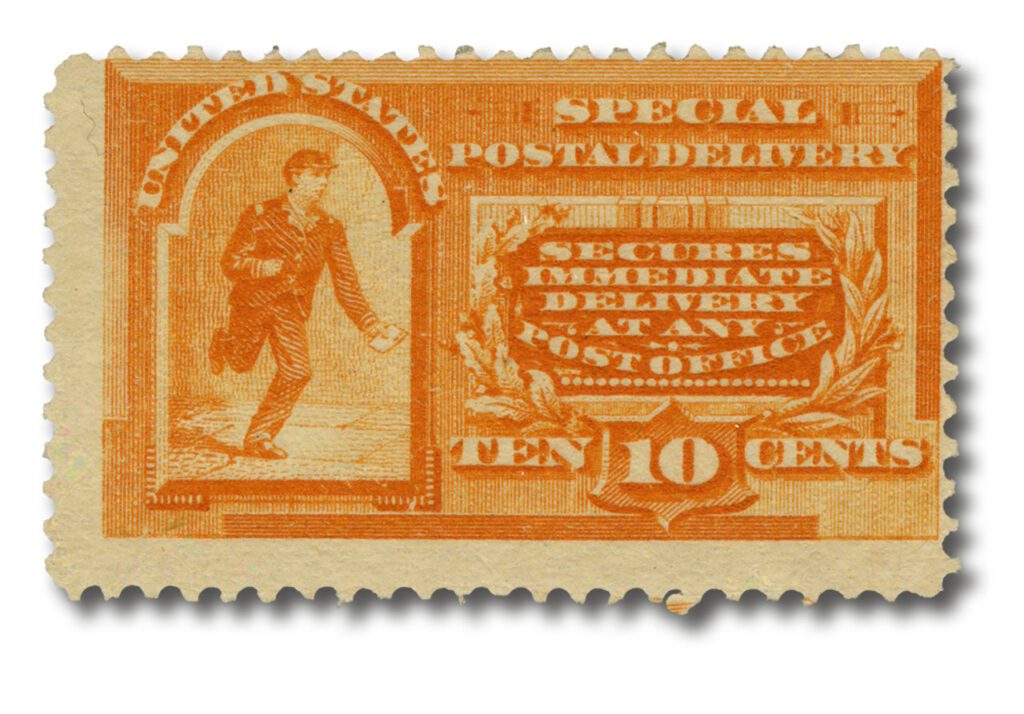
From the issue of #E1, the size and shape of Special Delivery stamps were unlike any other stamp. This changed with the 1893 release of the Columbian Series. Because the 1¢ Columbian stamp was issued in almost the same color as the #E2 Special Delivery stamp, the Post Office Department was forced to do something to avoid confusion. On January 10, 1893, Postmaster General Wanamaker declared all future Special Delivery stamps, starting with the new #E3, would be printed in light orange ink instead of the usual blue. However, because he also required post offices to use up their supply of #E2 first, the effect was essentially negated.
The first three Special Delivery stamps were printed by the American Banknote Company, But their contract was coming to an end in 1893, so the Post Office Department advertised for a new four-year contract. Among the three companies that bid, the Post Office Department chose the Bureau of Engraving and Printing (BEP). Their agreement began on June 9, 1894, and the BEP’s first Special Delivery stamps were issued on October 10. #E4 used the same die as previous stamps, with one major difference. This stamp features lines about 1.5 millimeters long underneath “Ten Cents.” This change easily distinguishes Bureau of Engraving and Printing stamps from the earlier American Banknote issues.
Before 1895, Special Delivery stamps had been issued on unwatermarked paper, but on August 16, 1895, stamps appeared on double-line watermarked paper. #E5 was the first, and was printed in various shades of dark blue or deep blue. There are also imperforate #E5 stamps, though they weren’t regular issues. They were created for The New York Times owner Wilbur E. Jones, who helped the Bureau of Engraving and Printing with technical problems at the start of their printing contract. Jones didn’t want money, but since he collected stamps, requested imperforate versions of then-current issues instead. These imperforates are extremely rare today.
When the Post Office Department ordered the Bureau of Engraving and Printing to create a new series of postage stamps in 1902, they also requested new Special Delivery stamps. Artist R. Ostrander Smith (the same artist who designed the frames for the 1901 Pan American stamps) proposed the design picture a delivery boy on a bicycle since the vehicles were frequently used for Special Delivery at that time. The idea was approved and Smith himself created the die before Ponickau and Ellis did the engraving. #E6 was issued December 9, 1902, on double-line watermark paper.
On December 12, 1908, the Post Office Department issued #E7, the 10¢ Helmet of Mercury Special Delivery stamp. Though the design had been adapted over the years, the 1908 stamp was drastically different. Whitney Warren, a famous New York City architect, designed #E7, which incorporated a winged hat to symbolize speedy delivery. The symbol was borrowed from the ancient Roman god Mercury, messenger of the gods, the god of roads and travel, as well as the god of commerce, property, and wealth. Mercury delivered messages wearing a winged hat and winged sandals, carrying a snake-entwined staff to protect him in his travels. It was the perfect symbol for modern special delivery workers for whom speed was essential.
Unfortunately, the Helmet of Mercury stamp was disliked from the beginning. It was also constantly mistaken for the 1907 Captain John Smith one-cent commemorative (Scott # 328), meaning letters didn’t receive the special handling customers had paid for. Overnight, the stamp was sarcastically nicknamed “The Merry Widow,” after a Broadway play running at the time. Americans of the era were extremely practical – many felt the stamp’s design was frivolous. The demise of the Merry Widow was sealed with the retirement of Postmaster General Myer on March 6, 1909. His successor, Frank H. Hitchcock, discontinued the E7 June 9th, 1909.
In April 1901, the Bureau of Engraving and Printing decided to switch from double-line to single-line watermark paper the following year. However, it wasn’t until August 22, 1910, that the new single-line paper first appeared. #E8 was issued in January 1911, with a completely new set of plates created at the same time. Instead of the usual 100 stamps per plate, the plates for #E8 featured 200. Unlike previous stamps, the Bureau imprint to the left of the plate number was eliminated for #E8.
Until the issue of #E9, all Special Delivery stamps were perforated 12. #E9 is perforated 10 and was issued in September 1914 on single-line watermark paper. Some covers are known to exist sent from Canada from the United States featuring #E9. While Canada had their own Special Delivery system and stamps, most large Canadian cities stocked a number of US Special Delivery stamps, too. This was done to help make international communications easier.
#E10 was issued on October 19, 1916, on unwatermarked paper and perforated 10. It is found in many different shades ranging from ultramarine to blue. #E10 is the scarcest of all Special Delivery Stamps featuring the bicycle design.
The last Special Delivery stamp to feature the bicycle design – #E11 – was issued on May 2, 1917, on unwatermarked paper, perforated 11. It’s found in pale ultramarine, dark ultramarine, gray-violet, and blue. Some examples of #E11 were printed with experimental aniline ink, giving the back of the stamp a pink tinge. These stamps were nicknamed “pinkbacks,” as the pink doesn’t show through to the front of the stamp.
The first Special Delivery stamp to picture a motorcycle in its design was #E12, issued July 12, 1922, and perforated 11 on unwatermarked paper. It can be found in gray-violet and deep ultramarine. Collectors speculated on what type of motorcycle was pictured on the stamp, and it was concluded it was a hybrid between the then-popular Indian and Harley Davidson. #E12 was the first Special Delivery stamp since #E1 to have First Day Covers sold on its first day of issue. It may also have been the first-ever non-commemorative US postage stamp to have First Day Covers, as most collectors of the time were only interested in commemorative stamps on First Day Cover.
The Postal Service Act was passed on February 28, 1925, and created two new rates for Special Delivery of parcels. #E13 was the first stamp with a rate over the usual 10 cents. It was issued on April 11, 1925, and was intended for parcels between two and 10 pounds. Messengers were given 11¢ of the 15¢ rate for delivery. By the time #E13 was issued, First Day Cover popularity had increased greatly since the issue of #E12, and about 500 covers were issued for #E13. The 15¢ Special Delivery stamp cover could be paired with a 5¢ definitive and cover the international mail rate.
The design of Special Delivery stamp #E14 was based on a Washington, DC, photograph of a then-current US mail truck. This stamp was issued April 25, 1925, and, according to philatelic writer Steven G. Rich, pictures a Pierce Arrow mail truck in production sometime before 1920. He identified the model based on the driver’s seat being on the right side with the throttle and brake levers close next to the door. #E14 paid the Special Delivery postage of packages weighing 10 pounds or more.
On November 29, 1927, the US Post Office Department decided to return to the same Special Delivery stamp design used in 1922. The new stamp – #E15 – was issued in gray violet with some shades existing of red-lilac, gray-lilac, and violet. It was the first stamp in the new series of rotary press printings and between 500 and 1,000 First Day Covers were made. Several interesting varieties of this stamp exist, including examples with a vertical row of perforations missing and a gouged plate variety known as the “broken window pane.”
The 1931 15¢ orange Special Delivery stamp features the same design as the 1925 stamp, but with new plates made for printing with the rotary press. #E16 was issued August 13, 1931, in Washington, DC, with 750 to 1,000 First Day Covers produced. However, some covers have been discovered with a First Day of Issue of August 6, and postmarked from Easton, Pennsylvania.
Since Special Delivery service began in 1885, the letter rate had always been 10¢. #E17 was issued in 1945, and marked an increase from 10¢ to 13¢, the first increase in over 59 years. This stamp features the same design as the earlier motorcycle Special Delivery stamps aside from the change in denomination.
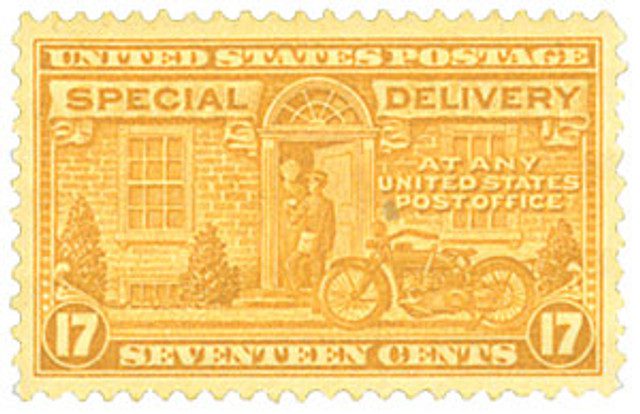
Like #E17, #E18 also marked a rate increase. The stamp was issued October 30, 1944, and increased the price of Special Delivery of mail between two and 10 pounds from 15¢ to 17¢. #E18 was printed on unwatermarked paper on electric eye plates of 200 with four panes of 50 each. The design is the same as other motorcycle Special Delivery stamps, though with a change in denomination.
On July 1, 1945, US Special Delivery Service ended the fee basis for messengers and they were converted to hourly employees. This meant messengers no longer got paid for every delivery they made each day, and so there was no incentive for them to hurry. The Post Office Department faced several years of trial and error before finding ways to make the new system work best for everyone. #E19 was issued November 30, 1951, after the Post Office had resolved some of the issues, but was presented with a new problem of finding enough vehicles to use for Special Delivery service.
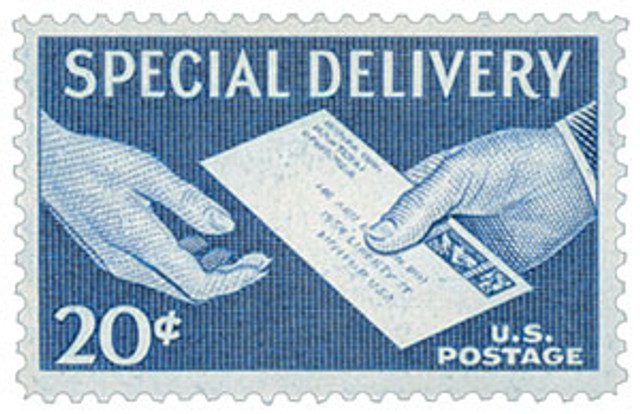
The issue of Special Delivery stamp #E20 was the first time since 1925 that the series saw a design change. This stamp pictures a letter being passed between the Special Delivery messenger and the customer. #E20 was printed by rotary press in deep blue, though shades of light blue are also known.
After World War II, the cost of Special Delivery Service was on the rise and the Post Office Department had still not come up with a solution for slower messenger service. #E21 was issued September 3, 1957, with a First Day of Issue ceremony in Indianapolis, Indiana. Not long after its issue, the Post Office Department began a series of experiments in different post offices to determine how they could save the declining Special Delivery service.
A new Special Delivery stamp design was issued on November 21, 1969, picturing two arrows pointing in opposite directions. #E22 was printed in carmine and violet-blue on unwatermarked paper by Giori Press Printing. The First Day of Issue ceremony was held in New York City.
The very last US Special Delivery stamp – #E23 – was issued May 10, 1971. The First Day of Issue ceremony was held in Phoenix, Arizona. It pictures the same design as #E22 and was also printed on unwatermarked paper by Giori Press Printing. Special Delivery Service lasted another 26 years before the USPS ended it June 7, 1997. Because this left many unused Special Delivery stamps in circulation, the USPS authorized customers to return the stamps for their face value since “services were not rendered.”
Today, Priority Mail and Express Mail have taken the place of Special Delivery services.
Click here for more Special Delivery sets and formats.
| FREE printable This Day in History album pages Download a PDF of today’s article. Get a binder or other supplies to create your This Day in History album. |
Discover what else happened on This Day in History.

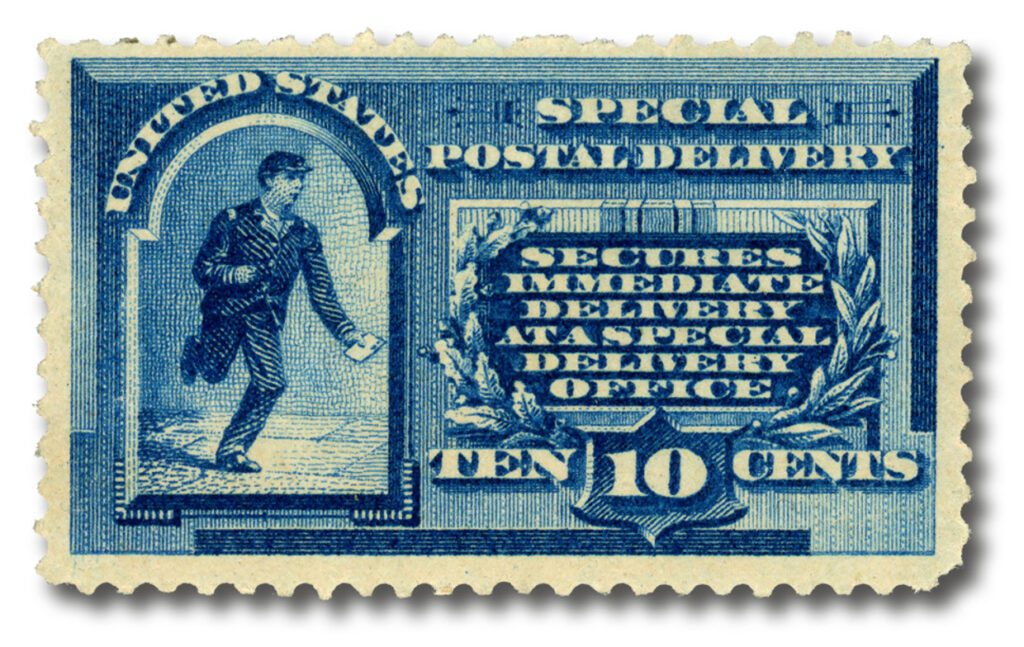
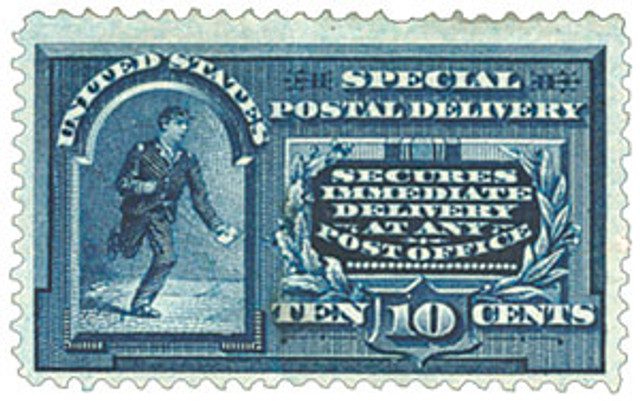
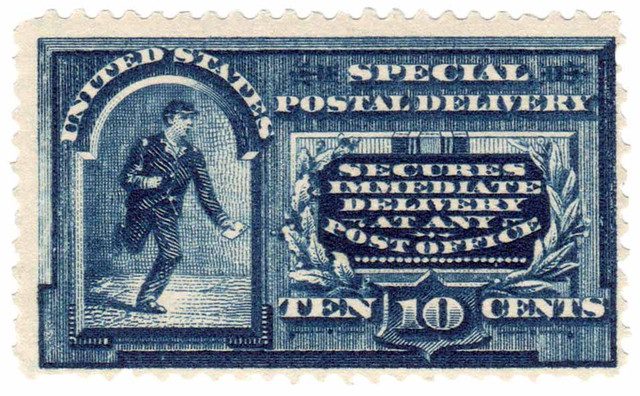
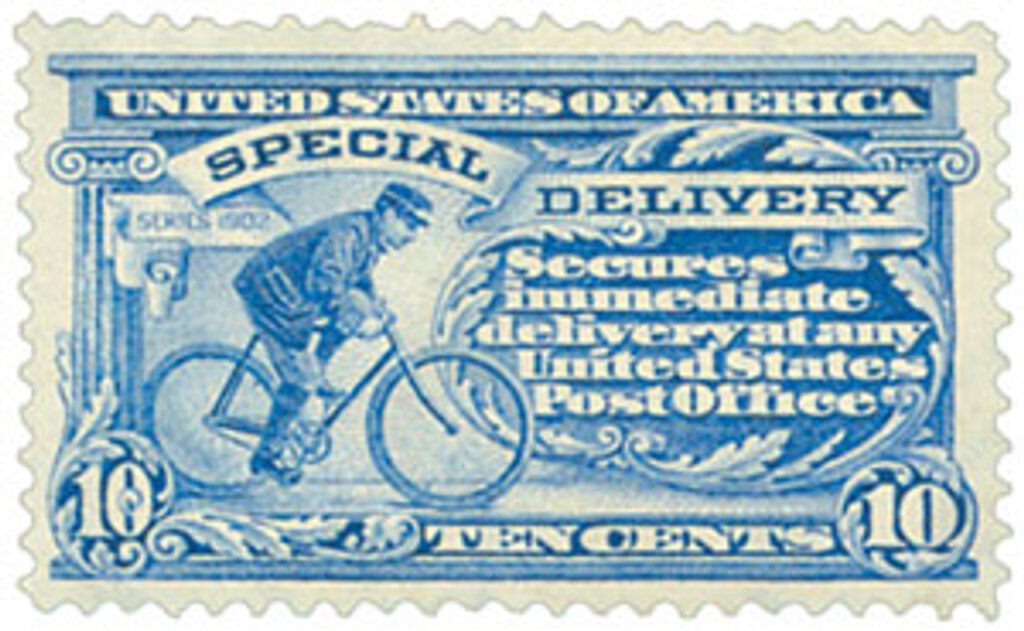
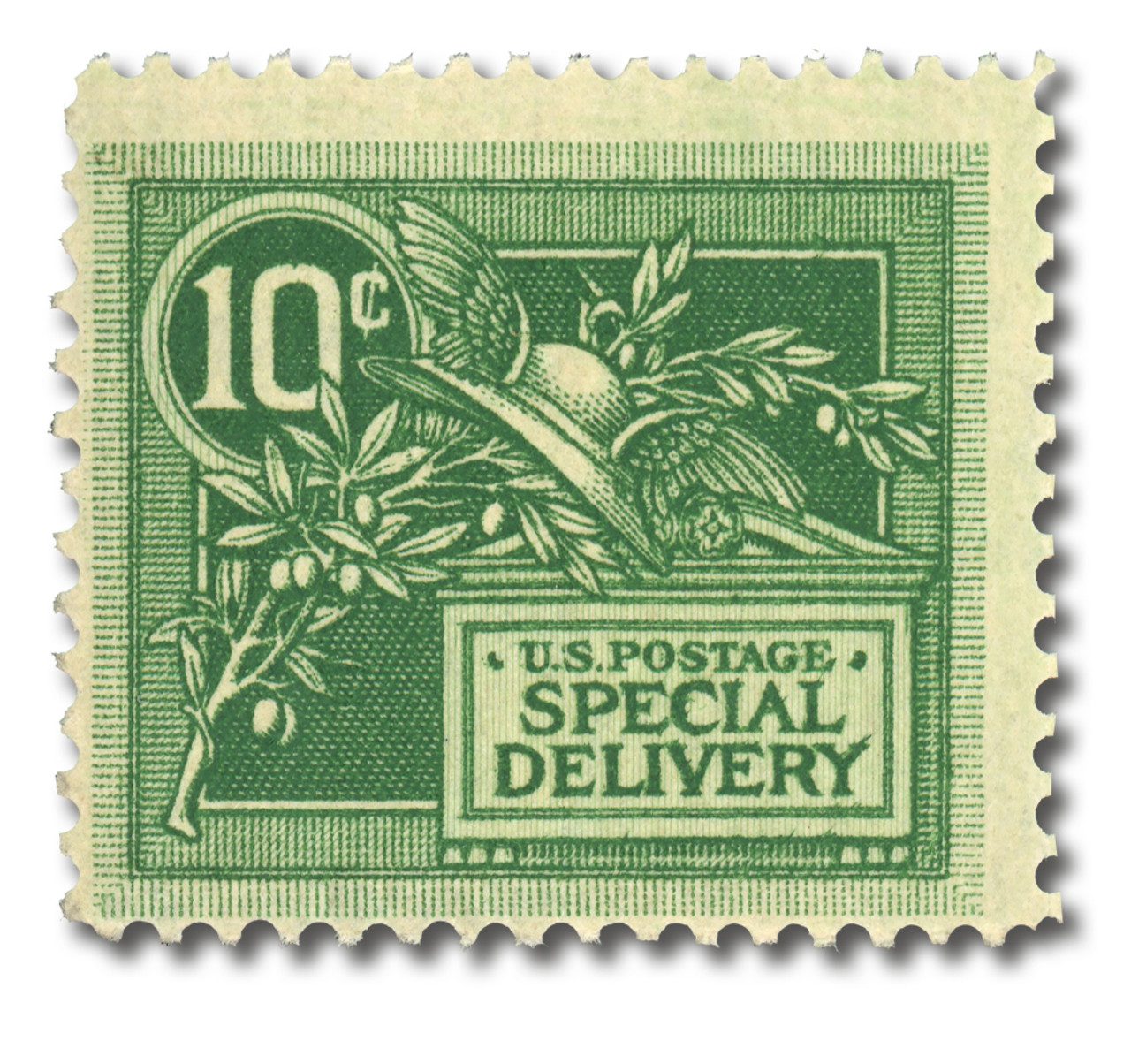

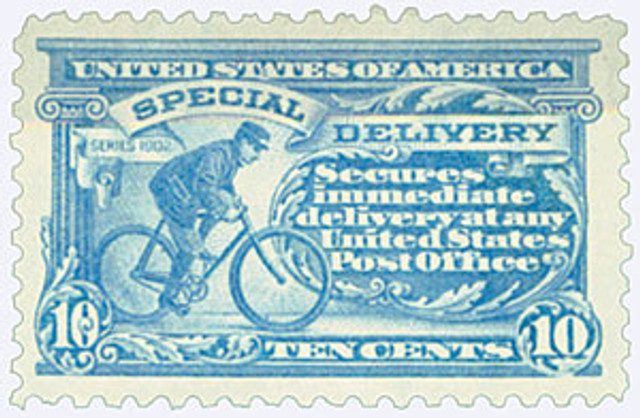
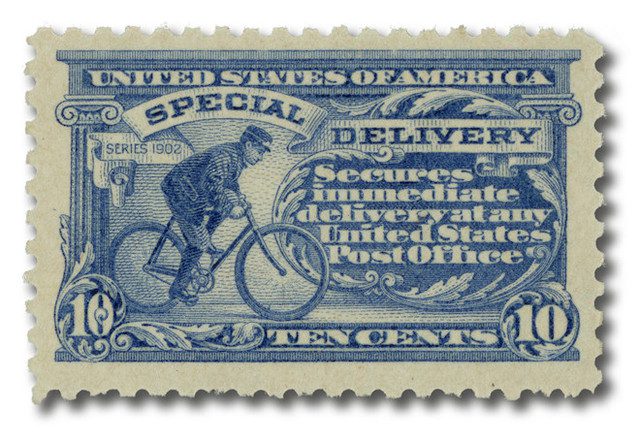
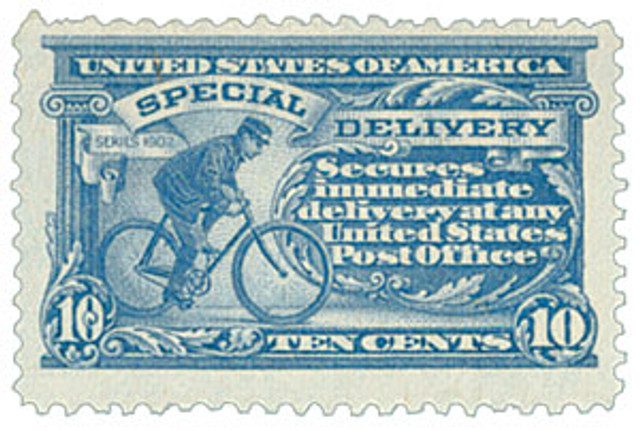

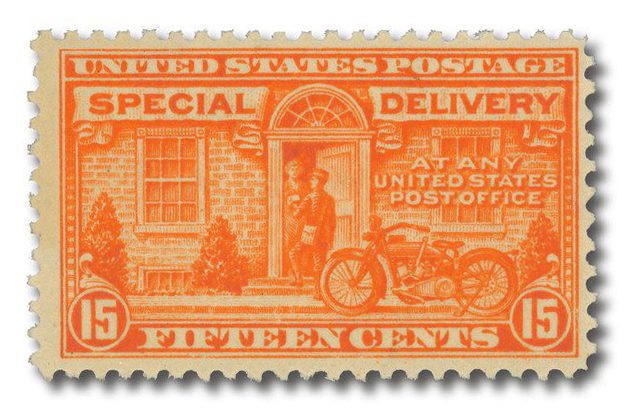
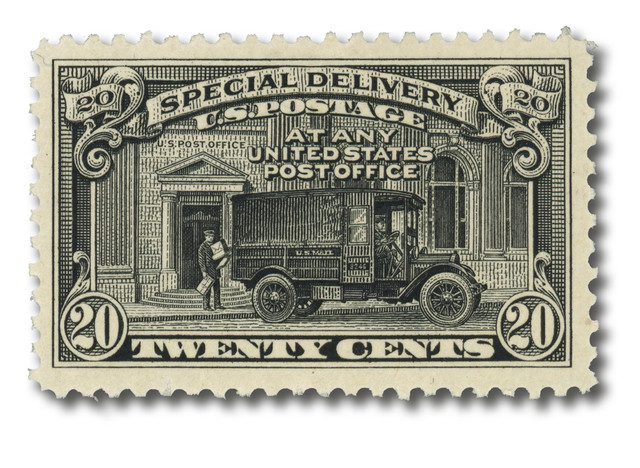
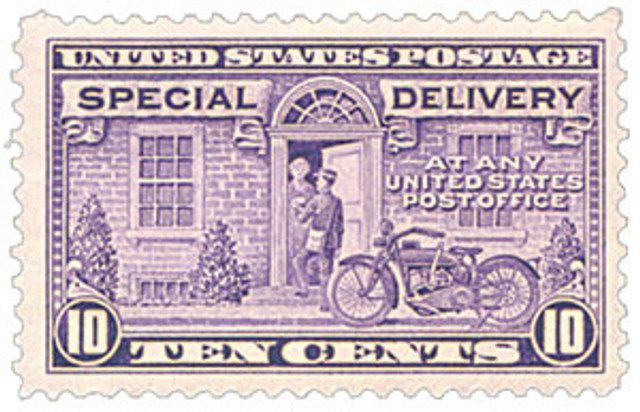
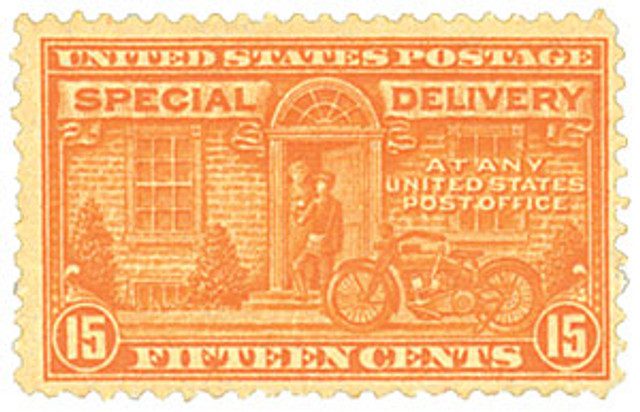
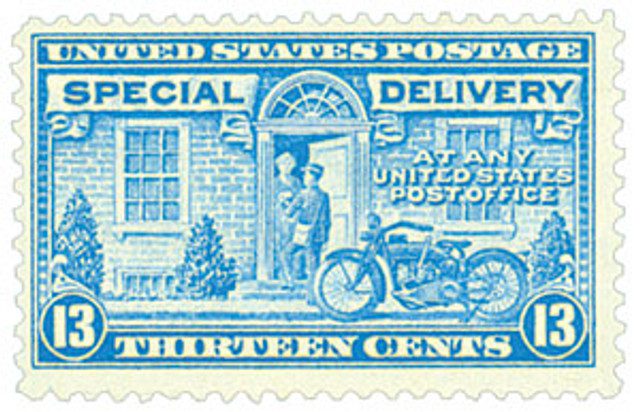
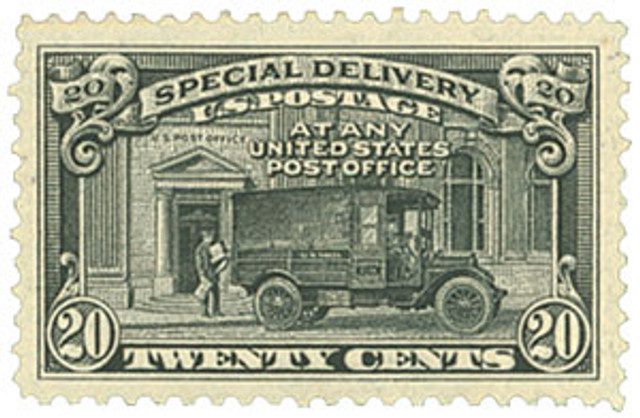
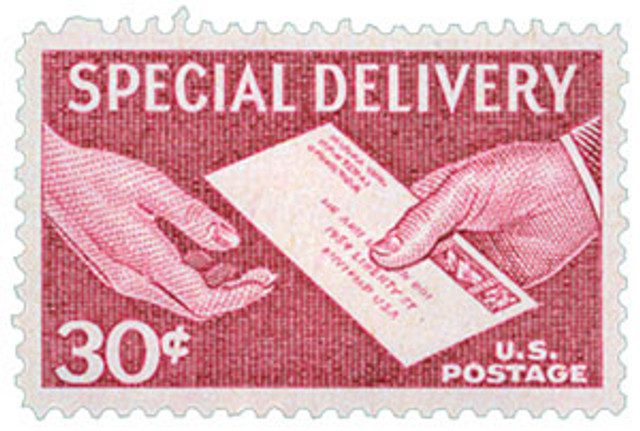
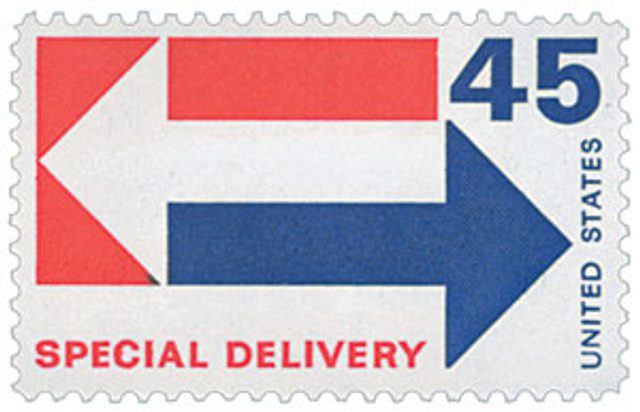
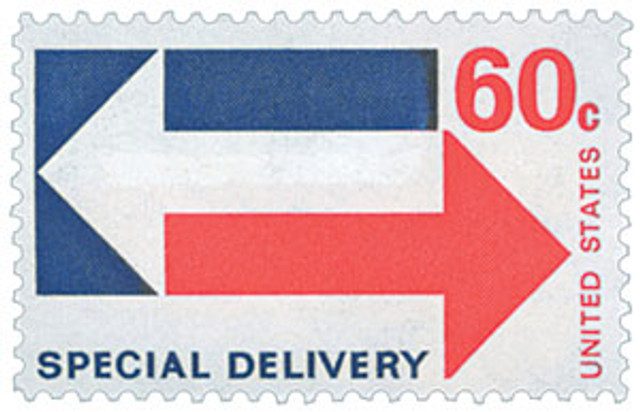

Interesting article. I am curious as to what this special delivery service cost in 1885, 1886, to 1888.
Looks like all the early stamps have 10 cents printed on them.
It’s 10 cents. It’s on the stamp.
Great history lesson! Thanks!!
Dr. Morrell
Very interesting article and how important egular mail delivery was and is to communities.
Very interesting. I learn so much from your posts.
A treasured piece of history. I enjoy Rural Free Delivery today!
Happy National Stamp Collecting Month for stamp collectors 🙂
Again we find a piece of history that made this country great. Thank you for the reminder.